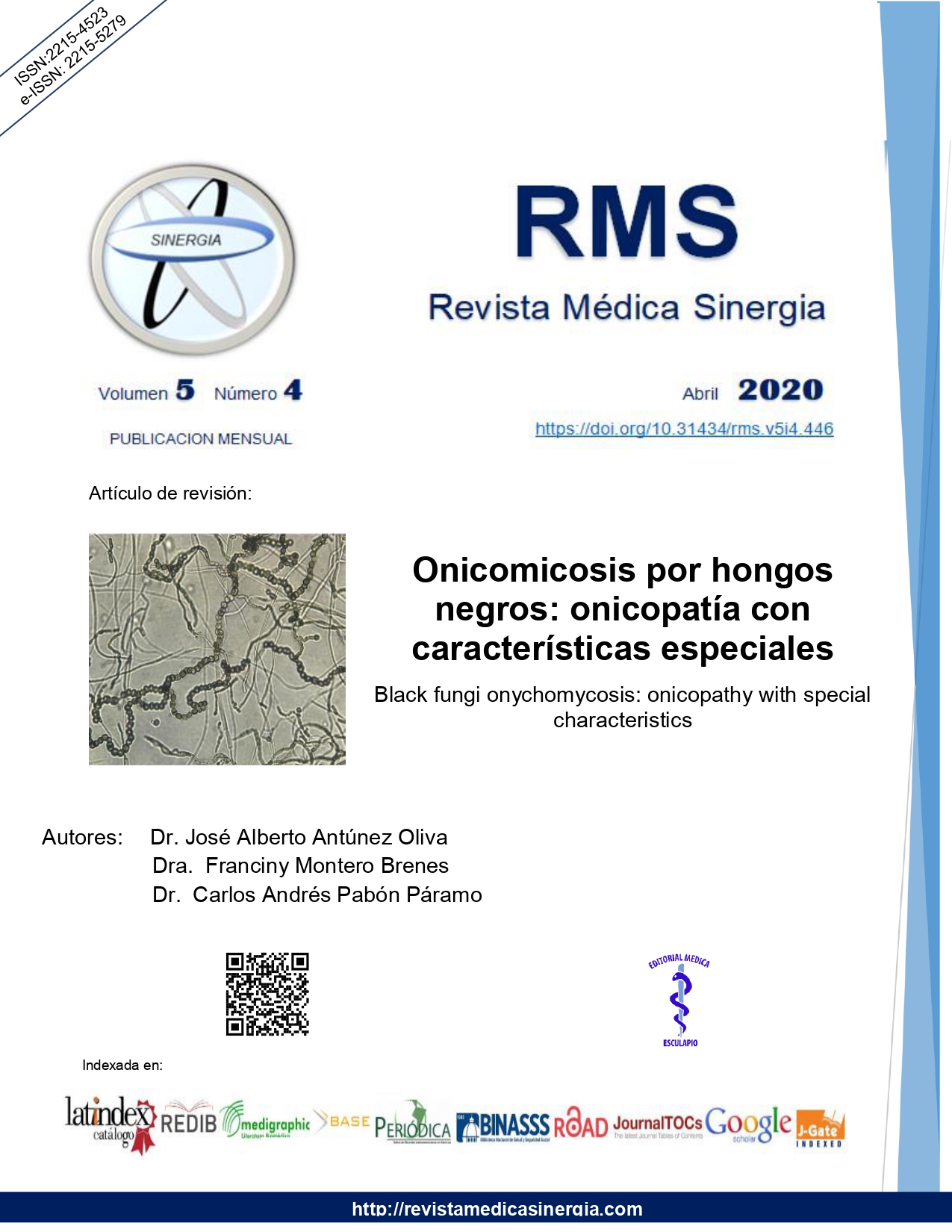Abstract
Black fungal onychomycosis also known as pheohifomycosis of the nail, is part of the condition called fungal melanonychia, which has been known for several years. The etiologic agents of this infection are black or demataceous fungi, which usually act as opportunistic pathogens causing invasion and infection, taking advantage from a predisposing factor. It has a universal distribution and is endemic in several countries. It can be found in different climates and ecosystems. This type of fungi has specific pathogenicity factors that make it easier for them to develop in the host. Affected patients may have a variable spectrum in the clinical presentation of nail pathology, which is important to know so that an appropriate differential diagnosis is made with other pathologies both benign and malignant. Currently, for the diagnosis of this type of onychomycosis, it is required to have a direct microscopic observation, cultures in unconventional media and a high clinical suspicion. With regard to antifungal therapy, it is known to be exceptionally difficult and that this kind of fungi have a poor response to the antifungals that are used nowadays.
Keywords
References
Ajello L, Georg LK, Steigbigel RT, Wang CJK. A case of phaeohyphomycosis caused by a new species of Phialophora. Mycologia. 1974;66(3):490-498. https://doi.org/10.1080/00275514.1974.12019630
Campos-Macias P, Arenas R. Pigmented Onychomycosis (Fungal Melanonychia). En: Onychomycosis. Springer; 2017. p. 85-101. https://doi.org/10.1007/978-3-319-44853-4_9
Revankar SG. Phaeohyphomycosis: infection due to dark (dematiaceous) molds. En: Diagnosis and treatment of fungal infections. Springer; 2015. p. 151-157. https://doi.org/10.1007/978-3-319-13090-3_12
Gupta AK, Versteeg SG, Shear NH. Onychomycosis in the 21st century: an update on diagnosis, epidemiology, and treatment. J Cutan Med Surg. 2017;21(6):525-539. https://doi.org/10.1177/1203475417716362
Hay RJ, Ashbee HR. Fungal infections. Rooks Textb Dermatol Ninth Ed. 2016;1-110. https://doi.org/10.1002/9781118441213.rtd0033
Chowdhary A, Perfect J, de Hoog GS. Black molds and melanized yeasts pathogenic to humans. Cold Spring Harb Perspect Med. 2015;5(8):a019570. https://doi.org/10.1101/cshperspect.a019570
Hussain N, Revankar SG. Black mold infections: what we know and what we need to know. Curr Clin Microbiol Rep. 2017;4(2):106-111. https://doi.org/10.1007/s40588-017-0062-x
Hay RJ. Dermatophytosis (ringworm) and other superficial mycoses. Mand Douglas Bennett's Princ Pract Infect Dis Eighth Ed Phila PA Elsevier. 2015;2985-994. Disponible en: https://1a2ee5a1-a-62cb3a1a-s-sites.googlegroups.com/site/mandell2020c/home/266-DermatophytosisRingworm.pdf?attachauth=ANoY7cpwE2OqjN4fOJr4kZb8aj_QxZhAXIPxCRJpMn0s2UiGWJ7ZgFhPB_3-B3bLfk9FhirJuetwV7x4z-hVUt1hZduUV-_Zybzk98AhlbVarY8uOxocnHIGtJgNOVn06UiMDnHQsDEeu9EoLlx8jWkUKEYdPrWF38pHMT5DRpX6vqOmxHjrZrFrbGiH9hGK5XXuWDd8hmdFHmRQYl-e-LbhJJDnBtI_Tf6trx-uMb5M-ePdKGcK20K8clUh8IM5H0JiZkMNT67s&attredirects=0
Shokoohi GR, Ansari S, Abolghazi A, Gramishoar M, Nouripour-Sisakht S, Mirhendi H, et al. The First Case of Fingernail Onychomycosis Due to Neoscytalidium novaehollandiae, Molecular Identification and Antifungal Susceptibility. J Mycol Médicale. 2019;100920. https://doi.org/10.1016/j.mycmed.2019.100920
Martínez-Herrera EO, Arroyo-Camarena S, Tejada-García DL, Porras-López CF, Arenas R. Onychomycosis due to opportunistic molds. An Bras Dermatol. 2015;90(3):334-337. https://doi.org/10.1590/abd1806-4841.20153521
Papini M, Piraccini BM, Difonzo E, Brunoro A. Epidemiology of onychomycosis in Italy: prevalence data and risk factor identification. Mycoses. 2015;58(11):659-664. https://doi.org/10.1111/myc.12396
Elewski BE, Tosti A. Risk factors and comorbidities for onychomycosis: implications for treatment with topical therapy. J Clin Aesthetic Dermatol. 2015;8(11):38. Disponible en: https://www.ncbi.nlm.nih.gov/pmc/articles/PMC4689496/pdf/jcad_8_11_38.pdf
Cozzani E, Agnoletti AF, Speziari S, Schiavetti I, Zotti M, Persi A, et al. Epidemiological study of onychomycosis in older adults with onychodystrophy. Geriatr Gerontol Int. 2016;16(4):486-491. https://doi.org/10.1111/ggi.12496
Brandt ME, Warnock DW. Epidemiology, clinical manifestations, and therapy of infections caused by dematiaceous fungi. J Chemother. 2003;15(sup2):36-47. https://doi.org/10.1179/joc.2003.15.Supplement-2.36
Romano C, Gianni C, Difonzo EM. Retrospective study of onychomycosis in Italy: 1985-2000. Mycoses. 2005;48(1):42-44. https://doi.org/10.1111/j.1439-0507.2004.01066.x
Smith DF, Casadevall A. The Role of Melanin in Fungal Pathogenesis for Animal Hosts. Fungal Physiol Immunopathogenesis. 2019;1-30. https://doi.org/10.1007/82_2019_173
Gómez LV, Cardona-Castro N. Feohifomicosis, una infección fúngica oportunista emergente. CES Med. 2016;30(1):66-77. https://doi.org/10.21615/cesmedicina.30.1.7
Gupta AK, MacLeod MA, Tosti A. Onychomycosis: Clinical Aspects. En: Scher and Daniel's Nails. Springer; 2018. p. 153-159. https://doi.org/10.1007/978-3-319-65649-6_9
Lipner SR, Scher RK. Onychomycosis: Clinical overview and diagnosis. J Am Acad Dermatol. 2019;80(4):835-851. https://doi.org/10.1016/j.jaad.2018.03.062
Torres-Guerrero E, Arenas R. Candida Onychomycosis. En: Onychomycosis. Springer; 2017. p. 73-83. https://doi.org/10.1007/978-3-319-44853-4_8
Lipner SR, Scher RK. Onychomycosis: Clinical overview and diagnosis. J Am Acad Dermatol. 2019;80(4):835-851. https://doi.org/10.1016/j.jaad.2018.03.062
Eenglish MP. NAILS AND FUNGI. British Journal of Dermatology. 1976 06;94(6):697-701. https://doi.org/10.1111/j.1365-2133.1976.tb05171.x
Saldaña M, Férez-Blando K, Domínguez-Cherit J, Fierro-Arias L, Bonifaz A. Fungal Leukonychia and Melanonychia: a Review. Curr Fungal Infect Rep. 2017;11(3):110-116. https://doi.org/10.1007/s12281-017-0289-2
Tseng Y-T, Liang C-W, Liau J-Y, Chang K, Tseng Y-H, Chen J-S, et al. Longitudinal melanonychia: differences in etiology are associated with patient age at diagnosis. Dermatology. 2017;233(6):446-455. https://doi.org/10.1159/000486701
Koga H. Dermoscopic evaluation of melanonychia. J Dermatol. 2017;44(5):515-517. https://doi.org/10.1111/1346-8138.13863
Haneke E. Important malignant and new nail tumors. JDDG J Dtsch Dermatol Ges. 2017;15(4):367-386. https://doi.org/10.1111/ddg.13223
Cob-Delgado M, Valverde-Brenes J. Dermatomicosis por Neoscytalidium dimidiatum Reporte de un caso Dermatomycosis by Neoscytalidium dimidiatum. Rev. Colegio de Microb Quim Clin de Costa Rica. 2018: 24 (3). Disponible en: http://revista.microbiologos.cr/wp-content/uploads/2018/12/Art%C3%ADculo-6.


